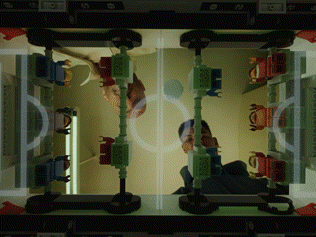🎪✨The Nexialist #0096
Anne Imhof's YOUTH | infoxication | content capital | bread and circus | sportswashing | rainbow flag as the enemy | the law of the instrument
welcome to another week of my cyber-patchwork, The Nexialist
hello, everyone! i hope this e-mail finds you well uninspired and even frustrated with what’s happening (?). today i’m bringing you some inspiration from inside a museum, Wikipedia rabbit holes, and other brain-sparking links. also the absurd case of LGBTQ+rainbow hating that is getting under my nerves. so with these spoilers, i’ll leave you to it.
1 year ago » 🛠✨The Nexialist #0046 : Tentacular Thinking | Tools for A System Thinker | Find True Belonging | Art, Science, Futures Studies | Mystic Truths | Trusting your Destiny | No Filter | Masculinity
🐎youth
this week my friend Raquel and i decided to go to one of my favorite museums in Amsterdam, the Stedelijk museum, to see the exhibition by german artist Anne Imhof. YOUTH was supposed to be shown in Moscow, but it was canceled due to the war.
i was quite impressed with what i saw and heard. the way it was designed brought us into an immersive experience, with lockers and other industrial elements, and made us feel the themes, sometimes even before we could confirm what they were trying to show. also, it was super cool; it felt like we were in some kind of movie or music video. the videos they created were excellent, as well as the music (there was even collaboration with Arca, who usually appears here). i was quite touched on how they worked with tensions that are pulsating in the zeitgeist and the youth, such as individualism x loneliness, freedom x pre-established routes, digital x IRL, and the emptiness despite the sea of stimuli.
i took one of the introductions to share with you. if you’re around Amsterdam, i highly recommend it.
ROMANTICISM x ZEITGEIST
Imhof often nudges Romanticism in her work, a movement that emerged at the tail end of the nineteenth century. Characterized by rapid industrialization and an increasing pace and mechanization of daily life, the period incited many artists to d reconnect with both nature and their inner world. Such efforts included the Arts & Crafts Movement in England and Romanticism in Germany. These movements held that imagination, intuition, and poetry could provide a remedy to the rationalism and ugliness of industry. In our current increasingly digitized and efficiency-driven world, we see a similar interest, with many artists once again seeking refuge in nature and emotional expression.
Anne Imhof poses the question whether this dichotomy between of the natural and the mechanical is de still relevant today or perhaps more relevant than ever. The installation's restrictive, oppressive layout suggests we may not even in be capable of exploring our natural selves within the current social and political confines. How do we escape the conditioning that has shaped us op since youth? Imhof explores various contemporary emotional responses to such restrictions: hyper-individualism and loneliness, desire and greed, saturation, and the fear of missing out. Perhaps her work expresses a longing for human relationships founded on intuition, and for the poetry and authenticity of nature.
read: Anne Imhof Took a Risk Embracing Emptiness In Her New Work. It Pays Off Powerfully | ArtNet
🧠infoxication
this week a term resurfaced in my inbox: infoxication. the e-mail came from coolbox and made me quite thoughtful: is the nexialist part of this infoxication movement? short answer: yes. and we all are.
With so many people talking all the time, opining and often even commanding in an imperative tone, we can lose our own inner voice and the path to self-knowledge and authenticity. Therefore, sometimes it is necessary to silence the noise outside and do intentional, selective and conscious self-curating about what content you want to consume - or not.
also, the truth is that a lot of the time, this platform helps me organize my thoughts and create narratives with what i see around me, just like i’m doing at this exact moment. so please, remember to do that for yourself as well, on paper, online, or just in your mind. you’re also a nexialist 🤯
the discussion is not new, of course, and has been around for centuries. in fact, there's a lot about it. it was one of those Wikipedia pages that led me into a rabbit hole.
The advent of modern information technology has been a primary driver of information overload on multiple fronts: in quantity produced, ease of dissemination, and breadth of the audience reached. Longstanding technological factors have been further intensified by the rise of social media and the attention economy, which facilitates attention theft. In the age of connective digital technologies, informatics, the Internet culture (or the digital culture), information overload is associated with over-exposure, excessive viewing of information, and input abundance of information and data.
👨🏻💻content capital
wow. this short but powerful piece by Kyle Chayka for The New Yorker was quite brain sparking: how the internet turned us into content machines. it starts defining “content” as “digital material that may circulate solely for the purpose of circulating.”
Eichhorn uses the potent term “content capital”—a riff on Pierre Bourdieu’s “cultural capital”—to describe the way in which a fluency in posting online can determine the success, or even the existence, of an artist’s work. Where “cultural capital” describes how particular tastes and reference points confer status, “content capital” connotes an aptitude for creating the kind of ancillary content that the Internet feeds upon. Since so much audience attention is funnelled through social media, the most direct path to success is to cultivate a large digital following.
it immediately made me think of the super industry of the imaginary (TN#28). another powerful term i learned here is to define the internet as a “living system.”
“The Internet Is Not What You Think It Is” begins as a negative critique of online life, particularly as seen from the perspective of academia, an industry that is one of its disrupted victims. But the book’s second half progresses into deeper philosophical inquiries. Rather than a tool, the Internet might best be seen as a “living system,” Smith writes. It is the fulfillment of a centuries-old human aspiration toward interconnectivity—albeit a disappointing one.
read: how the internet turned us into content machines | the new yorker
🥖bread and circus
it made me think about how the term “bread and circuses” work when our lives are inseparable from this constant content production/distraction dynamic.
In a political context, the phrase means to generate public approval, not by excellence in public service or public policy, but by diversion, distraction, or by satisfying the most immediate or base requirements of a populace, by offering a palliative: for example food (bread) or entertainment (circuses). Juvenal originally used it to decry the "selfishness" of common people and their neglect of wider concerns. The phrase implies a population's erosion or ignorance of civic duty as a priority.
and that, of course, immediately brought me to one of the best albums in Brazilian history and the manifesto of the Tropicalia movement, Tropicalia ou Panis et Circensis (1968). in the song with the album title, they sing: but the people in the dining room are busy with being born and dying. i guess today’s update would be: but the avatars in the living room are busy scrolling down their feeds (?)
⚽️sportswashing
The Syllabus shared the open-access article Sportswashing: Media headline or analytic concept? by Michael Skey. greenwashing, pinkwashing, techwashing… now sportswashing. capitalism and its forces cannot leave anything alone and love to use whatever is in its reach to maintain its power and cover up its failures. again, bread and circus.
Sportswashing is a neologism that has begun to appear with increasing regularity in the English-language media over the past few years. However, there has been limited academic discussion of the term and certainly no sustained analysis of what it might or might not offer to sports scholars. This lacuna is particularly curious given the rapid rise in interest in related issues, such as the links between sport and soft power, sporting mega events and place branding and sports diplomacy. Therefore, this paper has three main objectives. First to trace the links between sport and other forms of ‘washing’ (whitewashing, greenwashing etc) and to identify similarities and differences in these approaches. Second, to situate sportswashing within the wider literature on sports and state relations so as to better assess what, if anything, makes it different from cognate terms, including propaganda, public diplomacy, soft power and place branding. Third, to reflect on the utility of the concept, in both analytical and practical terms, in the contemporary era.
🌈rainbow flag as the enemy
Brazilian journalist at World Cup says regional flag mistaken for LGBTQ symbol. you can see the supercute flag above, and it belongs to the northeastern state of Pernambuco. it was even elected the most beautiful Brazilian flag on twitter a couple of years ago. so… this Brazilian journalist was mistreated for having this flag, and i don’t know which other word to use other than pathetic. in their mission to show authority and control, they seem more like clumsy evil robots.
i usually avoid showing my frustration and annoyiance here, but i have to. this happens in less than a week after ClubQ massacre, showing how we cannot normalize anti LGBTQ+ rhetoric 🤦 it made me think of….
🔨the law of the instrument
The law of the instrument, law of the hammer, Maslow's hammer (or gavel), or golden hammer is a cognitive bias that involves an over-reliance on a familiar tool. Abraham Maslow wrote in 1966, "If the only tool you have is a hammer, it is tempting to treat everything as if it were a nail." The concept is attributed both to Maslow and to Abraham Kaplan, although the hammer and nail line may not be original to either of them.
I didn’t know it had a name, and now i do. if you see diversity and change as enemies, anything different from “normality” will be a target. i’m also quite guilty of doing that but in a more harmless level: i love trello and notion and many times i think they will solve a problem. many times they do though.
see you next week, youngsters 🫀
🫀If anything made your brain tingle, click like, and please share it with your friends. It helps The Nexialist to reach more curious minds.
🥰If someone amazing sent it to you, tell them you love them, and you can subscribe at thenexialist.substack.com.
❓If you want to know what a Nexialist is, click here.
💌I want to know what you think/who you are! Your feedback is highly appreciated, you can e-mail me or fill in this short survey. Thank you! 🙏🏻
🔌Let’s Collab?
I truly believe innovation comes from bringing improbable areas together, and that’s why I called this project The Nexialist. Some sectors are known to be self-referencing and hermetic. Sometimes teams are on autopilot mode, focused on the daily grind, which hinders innovation. As a Nexialist, I like to burst these bubbles, bringing references from different areas, and maintaining teams inspired and connected to the Zeitgeist.
I offer inspiration sessions called Brainsparks, creative desk research (Zeitgeist Boost), Plug’n’Play deals for workshops and sprints, and other bespoke formats. If you want to know more about this, send me an e-mail with your challenge(s) and we can figure something out together. Check out my website and some work I’ve done below:








Várias coisas pra comentar. Mas amei a exposição da Anne Imhof, ela até foi tema da minha news melhores de outubro (e amei que, assim como você, eu fui com a minha amiga Raquel.